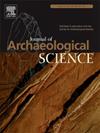Frozen motion: Contextualizing wheel rut data within and beyond the Pompeiian street grid
IF 2.6
1区 地球科学
Q1 ANTHROPOLOGY
引用次数: 0
Abstract
The past few decades have seen a growing use of GIS in archaeological research to study ancient movement at varying scales. In the case of urban networks, most spatial analyses of street systems have been modelled on pedestrian movement. At the site of Pompeii, however, recent scholarship has highlighted the ways in which the material evidence of the construction, use, and disuse of the street network inherently underlie the importance of vehicular traffic throughout the city. Dividing Pompeii's streets into discrete units of movement, this study geospatially maps wheel-rut measurements collected by the author onto previously published data of Pompeiian street paving and vehicular traffic. The resultant patterns between the paving history, traffic flow, and wheel-rutting across the street network reveal important transformations in the nature and extent of the city's connectivity to the surrounding countryside, and highlight the potential for similar approaches at other ancient urban centers.
冻结运动:上下文化车轮车辙数据内外庞培街道网格
在过去的几十年里,在考古研究中越来越多地使用GIS来研究不同规模的古代运动。就城市网络而言,大多数街道系统的空间分析都是以行人运动为模型的。然而,在庞贝遗址,最近的学术研究强调了街道网络的建设、使用和废弃的物证,这些物证本质上是贯穿整个城市的车辆交通重要性的基础。将庞贝的街道划分为离散的运动单元,本研究将作者收集的车轮-车胎测量数据与先前发表的庞贝街道铺装和车辆交通数据进行地理空间映射。铺路历史、交通流量和穿过街道网络的车轮车辙之间的结果模式揭示了城市与周围乡村连通性的性质和程度的重要转变,并突出了其他古代城市中心类似方法的潜力。
本文章由计算机程序翻译,如有差异,请以英文原文为准。
求助全文
约1分钟内获得全文
求助全文
来源期刊

Journal of Archaeological Science
地学-地球科学综合
CiteScore
6.10
自引率
7.10%
发文量
112
审稿时长
49 days
期刊介绍:
The Journal of Archaeological Science is aimed at archaeologists and scientists with particular interests in advancing the development and application of scientific techniques and methodologies to all areas of archaeology. This established monthly journal publishes focus articles, original research papers and major review articles, of wide archaeological significance. The journal provides an international forum for archaeologists and scientists from widely different scientific backgrounds who share a common interest in developing and applying scientific methods to inform major debates through improving the quality and reliability of scientific information derived from archaeological research.
 求助内容:
求助内容: 应助结果提醒方式:
应助结果提醒方式:


